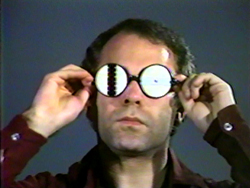Stuart Sherman
Biography
Stuart Sherman's influential art practice defies easy classification. Celebrated as an avant-garde performer, he also worked in film, video, and other visual arts, in addition to writing plays and poems. Sherman was an iconoclastic builder and manipulator of mass-produced bric-a-brac; he used an intuitive logic to purposefully transform objects into rhetorical questions. He developed these manipulations into an idiosyncratic performance style that was quick-paced and conceptually witty. The culminating tableaux, featuring Sherman and disassembled or repurposed objects, evoke Rene Magritte, Buster Keaton, and Samuel Beckett.
Sherman settled in New York City's Greenwich Village in the 1960s, where he was a performer with Charles Ludlam's Ridiculous Theatrical Company and Richard Foreman's Ontological-Hysteric Theater Company. Beginning in the late 1970s, Sherman developed a unique performance style that combined the influence of avant-garde theater and conceptual art practices. Remaining outside of any one artistic identity, Sherman considered his work to be performative and visual but with a "literary bent — (I) consider everything I do a form of writing." One summer in the 1960's, he lived in close company with the writer Carson McCullers, taken in as her personal reader during the last year of her life. He wrote a number of original plays and concise meditations on the works of Anton Chekhov and Bertolt Brecht, among others.
In addition to writing, Sherman was interested in working with time and space, words as objects, and vice versa. Exemplifying the cross-pollination of influences in his work, he referred to his performances as "animated drawings." Characteristically taking the form of "Spectacles," as he called them, these performances were usually short in duration — a matter of seconds or minutes — and involved a dead-pan manipulation of simple everyday objects, often over a folding-table. The effect was a dislocation of these objects from their familiar, practical origins, and the animation of new relationships with them.
Writing of Sherman's performances on the occasion of his death in 2001, long-time friend and supporter Richard Foreman called them "performances of daring and delicate awkwardness, complexity that made no concessions to anything but Stuart's iron will to understand how his own mental rhythms glued themselves to the world with which he collided every day."
Foreman's assessment echoed Sherman's own observations of his practice: "As visual as it is, all of my work is giving form to ideas. I find that in art in general, whatever the discipline, there's too often a fascination with the material aspects of the medium, the sensuous properties of the medium with too little attention to the ideas that form the material."
Stuart Sherman was born in Providence, R.I., in 1946 and died in 2001. He attended Antioch College in Yellow Springs, Ohio. His work has been performed and exhibited at venues such as the Performing Garage, The Museum of Modern Art, Mudd Club, The Kitchen, Franklin Furnace, Whitney Museum of American Art, and Theater for the New City, all in New York; Walker Art Center, Minneapolis; List Center at M.I.T., Cambridge, MA; Kunstmuseum Berne, Kunstmuseum Zurich, and Centre Georges Pompidou Center, Paris.
In 2009 Sherman was honored with two exhibitions in New York, Beginningless Thought/ Endless Seeing: The Works of Stuart Sherman, at 80WSE, and Stuart Sherman: Nothing Up My Sleeve, at PARTICIPANT, INC.
